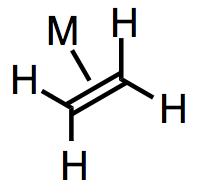Posts Tagged ‘alkynes’
Epic Ligand Survey: π Systems (Part 1)
 With this post, we finally reach our first class of dative actor ligands, π systems. In contrast to the spectator L-type ligands we’ve seen so far, π systems most often play an important role in the reactivity of the OM complexes of which they are a part (since they act in reactions, they’re called “actors”). π Systems do useful chemistry, not just with the metal center, but also with other ligands and external reagents. Thus, in addition to thinking about how π systems affect the steric and electronic properties of the metal center, we need to start considering the metal’s effect on the ligand and how we might expect the ligand to behave as an active participant in reactions. To the extent that structure determines reactivity—a commonly repeated, and extremely powerful maxim in organic chemistry—we can think about possibilities for chemical change without knowing the elementary steps of organometallic chemistry in detail yet. And we’re off!
With this post, we finally reach our first class of dative actor ligands, π systems. In contrast to the spectator L-type ligands we’ve seen so far, π systems most often play an important role in the reactivity of the OM complexes of which they are a part (since they act in reactions, they’re called “actors”). π Systems do useful chemistry, not just with the metal center, but also with other ligands and external reagents. Thus, in addition to thinking about how π systems affect the steric and electronic properties of the metal center, we need to start considering the metal’s effect on the ligand and how we might expect the ligand to behave as an active participant in reactions. To the extent that structure determines reactivity—a commonly repeated, and extremely powerful maxim in organic chemistry—we can think about possibilities for chemical change without knowing the elementary steps of organometallic chemistry in detail yet. And we’re off!
General Properties
The π bonding orbitals of alkenes, alkynes, carbonyls, and other unsaturated compounds may overlap with dσ orbitals on metal centers. This is the classic ligand HOMO → metal LUMO interaction that we’ve beaten into the ground over the last few posts. Because of this electron donation from the π system to the metal center, coordinated π systems often act electrophilic, even if the starting alkene was nucleophilic (the Wacker oxidation is a classic example; water attacks a palladium-coordinated alkene). The π → dσ orbital interaction is central to the structure and reactivity of π-system complexes.
Then again, a theme of the last three posts has been the importance of orbital interactions with the opposite sense: metal HOMO → ligand LUMO. Like CO, phosphines, and NHCs, π systems are often subject to important backbonding interactions. We’ll focus on alkenes here, but these same ideas apply to carbonyls, alkynes, and other unsaturated ligands bound through their π clouds. For alkene ligands, the relative importance of “normal” bonding and backbonding is nicely captured by the relative importance of the two resonance structures in the figure below.
Written by Michael Evans
January 30, 2012 at 1:04 am
Posted in content, ligand survey
Tagged with alkenes, alkynes, atom-metallation, backbonding, diastereomers, electrophilic attack, geometry, Heck reaction, ligand substitution, metallacyclopropane, migratory insertion, nucleophilic attack, olefin polymerization, pi systems, site selectivity, stereoselectivity, Wacker oxidation
